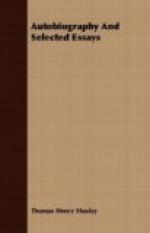On the other hand, notwithstanding all the fundamental resemblances which exist between the powers of the protoplasm in plants and in animals, they present a striking difference (to which I shall advert more at length presently), in the fact that plants can manufacture fresh protoplasm out of mineral compounds, whereas animals are obliged to procure it ready made, and hence, in the long run, depend upon plants. Upon what condition this difference in the powers of the two great divisions of the world of life depends, nothing is at present known.
With such qualifications as arises [98] out of the last-mentioned fact, it may be truly said that the acts of all living things are fundamentally one. Is any such unity predicable of their forms? Let us seek in easily verified facts for a reply to this question. If a drop of blood be drawn by pricking one’s finger, and viewed with proper precautions, and under a sufficiently high microscopic power, there will be seen, among the innumerable multitude of little, circular, discoidal bodies, or corpuscles, which float in it and give it its colour, a comparatively small number of colourless corpuscles, of somewhat larger size and very irregular shape. If the drop of blood be kept at the temperature of the body, these colourless corpuscles will be seen to exhibit a marvellous activity, changing their forms with great rapidity, drawing in and thrusting out prolongations of their substance, and creeping about as if they were independent organisms.
The substance which is thus active is a mass of protoplasm, and its activity differs in detail, rather than in principle, from that of the protoplasm of the nettle. Under sundry circumstances the corpuscle dies and becomes distended into a round mass, in the midst of which is seen a smaller spherical body, which existed, but was more or less hidden, in the living corpuscle, and is called its nucleus. Corpuscles of essentially similar structure are to be found in the skin, in the lining of the mouth, and scattered through the whole framework of the body. Nay, more; in the earliest condition of the human organism, in that state in which it has but just become distinguishable from the egg in which it arises, it is nothing but an aggregation of such corpuscles, and every organ of the body was, once, no more than such an aggregation.
Thus a nucleated mass of protoplasm turns out to be what may be termed the structural unit of the human body. As a matter of fact, the body, in its earliest state, is a mere multiple of such units; and in its perfect condition, it is a multiple of such units, variously modified.




